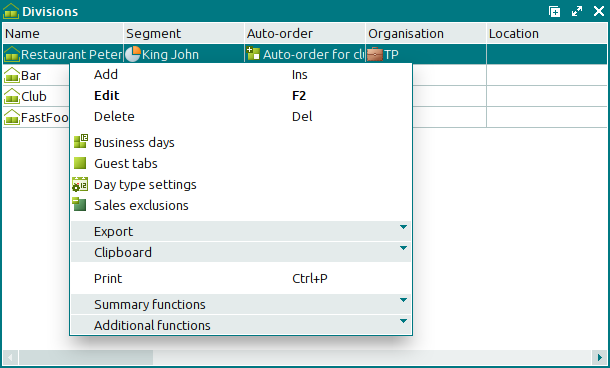- Menu
- Menu
- Sales
- Promotion rounding modes
- Business days
- Guest tabs
- Orders
- Bills
- Day type settings
- Stop list
- Promotion categories
- Auto-orders
- Store
- Sales records
- Transactions
- Partners
- Devices
- Devices
- Access
- Security levels
- Employee privilege sets
- Advanced
- Recycle bin
- Segments
- Locations
- How To
- How to set up an auto-order
- How to configure current on hand calculation
- How to set up a free employee meal system
- Configuration
- Tillypad XL POS configuration guide
© Tillypad, 2008-2015
The directory is used to manage all information related to divisions.
Location: – –.

Data grid columns:
Name is the name of the division.
Description is a brief description of the division.
Security level denotes the security level assigned to the division.
Carry over guest tabs determines whether or not guest tabs are carried over from one business day to the next.
Guest tab limit is the maximum allowed value of an open order (one which has not been paid for) for a given customer.
Guest tab promotion category is the promotion category automatically assigned to guest tabs that are opened in the division.
Auto-order is the auto-order automatically added to guest tabs that have been opened in the division.
Segment is the name of the segment, to which the division belongs.
Register sales records indicates the sales records registration method.
Business day processing defines how sales records are processed in the division.
Interval is the time interval between the generation of each sales record.
Order-ready message recipient is the device to which order-ready confirmation messages are sent.
Service provider is the service provider device for routing various messages between segments.
Rounding precision (sales) defines the accuracy of rounding for the division.
Document prefix denotes the code that is automatically added to reference numbers of documents within a given division.
Organisation is your enterprise, set as a partner.
Location designates the physical location of the division.
Bill building mode defines the mode of generating bills when prepaid credits are added to an order.
Promotion rounding mode is the promotion rounding mode that is set for discount calculation in orders.
Cumulative payment item is the payment menu item that is used in the division to pay for guest tabs in the cumulative mode (when making a prepayment).
Item for non-refundable balance is the menu item used to account for the nonrefundable part of the prepayment.
Service charge is a menu item used to include a service fee into the guest tab.
Tips is a menu item used to include tips into the guest tab.
System is a tag identifying system objects.
The context menu of the directory contains the following commands:
(Ins) – adds a new division to the directory.
(F2) – edits the selected divisions.
– opens a list of business days for the selected divisions.
– opens a list of guest tabs for the selected divisions.
– opens the Day type settings directory window for the selected divisions.
– opens a list of sales exclusions (stop list of the menu).
– menu with the commands to export files into an external file or update package.
– menu with the commands to operate the clipboard.
(Ctrl+P) – generates print layouts.
– menu with the commands to manage the summary functions of the data grid.
– menu with the commands to operate the data grid.
The and entry windows are used to add new divisions to the directory. The and editor windows are used to edit divisions.
When you delete divisions, a confirmation prompt appears.
The window is used to select divisions from the fields in other windows.

